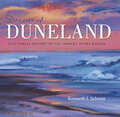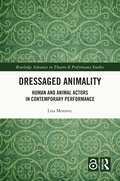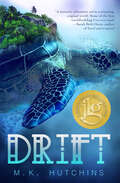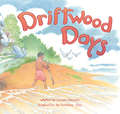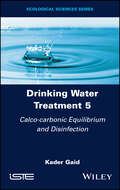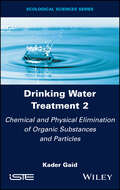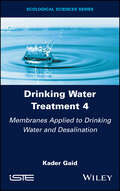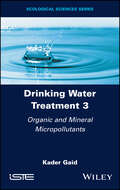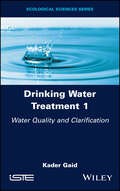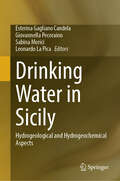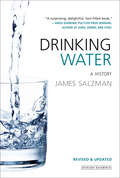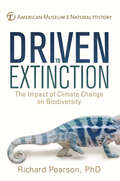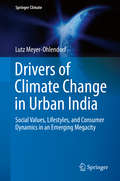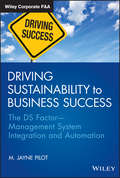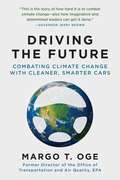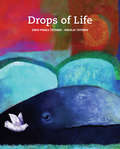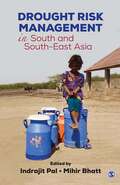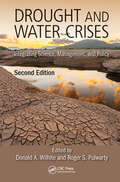- Table View
- List View
Dreams of Duneland: A Pictorial History of the Indiana Dunes Region
by Kenneth J. SchoonThe towering sand dunes along Lake Michigan not far from Chicago are one of the most unexpected natural features of Indiana. Dreams of Duneland is a beautifully illustrated introduction to the Dunes region, its history, and future prospects. This area of shifting sands is also a place of savanna, wetland, prairie, and forest that is home to a wide diversity of plant and animal species. The preserved area of the Indiana Dunes National Lakeshore sits by residential communities, businesses, and cultural attractions, evidence of a long history of competition for the land among farmers, fur traders, industrialists, conservationists, and urban and recreational planners. With more than 400 stunning images, the book brings to life the remarkable story of this extraordinary place.
Dreamy Quilts: 14 Timeless Projects to Welcome You Home
by Lydia Loretta NelsonHome is where the quilt is Transform your living space into a relaxing retreat when you stitch up soft, simple, and naturally beautiful quilts. Fourteen easy-to-sew projects range from quilts and throw pillows to a pretty patchwork dog bed. Author and designer Lydia Loretta Nelson’s soothing, handmade touches lend a touch of warmth to every room in your home—including all the spaces where memories are made. Fold a quilt over the nursery rocker or drape a patchwork throw over the sofa to personalize your house, apartment, or dorm room. Quilters of all skill levels will appreciate Lydia’s fresh designs and timeless, calming color palettes. 14 easy patchwork and appliqué projects include quilts, pillows, and a pet bed Low volume quilts lend a lovely, welcoming feel to any home decor Create timeless decor to personalize your living space—dream houses and temporary digs alike
Dressaged Animality: Human and Animal Actors in Contemporary Performance (Routledge Advances in Theatre & Performance Studies)
by Lisa MoravecThe book applies a productive interdisciplinary lens of art history, performance, and animal studies for approaching political economy issues, critiquing anthropomorphic worldviews, and provoking thoughts around animal and human nature that spark impulses for an innovative performance aesthetics and ethics.It combines Marxist analysis with feminist and posthumanist methodology to analyse the relation between ‘societal dressage’ and ‘bodily animality’ that humans and animals share. Within this original theoretical framework, the book develops the concept of ‘dressaged animality’ as a mode of critique to analyse the social and political function of interdisciplinary forms of ‘contemporary performances.’Drawing on archival and primary research, the book theorises and historicises more than 15 performance practices in which animality is allegorically staged through by humans danced, real, or filmically mediated animals. It focuses on Rose English’s pioneering approach to performance-making as well as on overlooked performances by other renown and largely unknown American (Mike Kelley/Kate Foley, Robert Morris, Bruce Nauman, Yvonne Rainer, Diana Thater), British (Mark Wallinger, Rose English), and European artists (Tamara Grcic, Judith Hopf, Joseph Beuys, Bartabas) from the late 1960s until the late 2010s. While various types of artistic practice are framed as forms of critique (for example, protest art, interventionist strategies, institutional critique), the book maps an original performance theory in art which shows that contemporary artistic performances can also take up a critique of societal dressage.This study will be of great interest to students and scholars in art history, theatre, dance and performance studies, and ecology, as well as to artists and curators working with performance.
Drift
by Megan HutchinsTenjat joins a dangerous defense to protect his island home from the monsters who threaten it in this fresh YA fantasy inspired by Mayan and Indian folklore.There's no place for love on the shores of Hell. Tenjat lives on the shores of Hell, an ocean filled with ravenous naga monsters. His island, a massive Turtle, is slowed by the people living on its back. Tenjat is poor as poor gets: poor enough, even, to condescend to the shame of marriage, so his children can help support him one day. But Tenjat has a plan to avoid this fate. He will join the Handlers, those who defend and rule the island. Handlers never marry, and they can even provide for an additional family member. Against his sister's wishes, Tenjat joins the Handlers. And just in time: the Handlers are ramping up for a dangerous battle against the naga monsters, and they need every fighter they can get. As the naga battle approaches, Tenjat's training intensifies, but a long-hidden family secret-not to mention his own growing feelings for Avi-put his plans in jeopardy, and might threaten the very survival of his island.
Driftwood Days
by William MiniverUnder autumn leaves, a boy watches a beaver build a dam. One of the branches slips away, carried downstream by the river. Through the changing seasons, the branch makes a long, epic journey to the sea, before finally getting tossed back onto shore. Changed by the elements, the branch—now driftwood—lies patiently on the beach, until the boy discovers it once again.Featuring breathtaking artwork by Charles Vess, Driftwood Days offers readers a beautiful, multilayered story about nature, science, childhood, and change.
Drinking Molotov Cocktails with Gandhi
by Mark BoyleMore than ever, people are longing for deep and meaningful change. Another world is not only possible; it is essential. Yet despite our creative and determined efforts to attain social justice and ecological sustainability, our global crises continue to deepen.In Drinking Molotov Cocktails with Gandhi, best-selling author Mark Boyle argues that our political and economic system has brought us to the brink of climate catastrophe, ransacking ecosystems and unraveling communities for the benefit of the few at the expense of the many. He makes a compelling case that we must "rewild" the political landscape, as history teaches us that positive social change has always been wrought by movements prepared to use any means available.The time has come for pacifists, revolutionaries, and freedom fighters to work together for the creation of a world worth sustaining. Eloquent, visionary, and beautifully written, this incendiary manifesto strikes at the heart of the world's crises and reframes our understanding of how to solve them, signaling a turning point in our journey towards an ecologically just society.The three R's of the climate change generation--reduce, reuse, and recycle--are long overdue for an upgrade .Welcome to resist, revolt, rewild.Mark Boyle is the author of The Moneyless Man and The Moneyless Manifesto. He lived completely without money for three years, and is a director of the global sharing community streetbank.com.
Drinking Water Treatment, Calco-carbonic Equilibrium and Disinfection
by Kader GaidToday, hundreds of millions of people drink contaminated water without knowing it. Yet water treatment technologies can effectively eliminate contamination and can supply urban and rural populations with safe drinking water in a secure way. For almost two centuries, the huge number of treatments available to guarantee water quality has grown alongside technological progress, the strengthening of industry norms and the reinforcement of consumer expectations. New treatment methods have been developed according to the advancement of knowledge and new sanitary regulations. This five-volume book sets out to clearly present the variety of treatments available along with their performance, limitations and conditions of use as well as ways to combine them to produce safe drinking water, which is a basic need essential to everyday life. The author shares his expertise acquired at Veolia, a company that is a world leader in water services and sanitation, desalination of sea water and the recycling of wastewater. Founded in France in 1853 to bring safe water to populations and to protect them from waterborne epidemics which ravaged cities, its history is intertwined with that of water treatment.
Drinking Water Treatment, Chemical and Physical Elimination of Organic Substances and Particles
by Kader GaidToday, hundreds of millions of people drink contaminated water without knowing it. Yet water treatment technologies can effectively eliminate contamination and can supply urban and rural populations with safe drinking water in a secure way.For almost two centuries, the huge number of treatments available to guarantee water quality has grown alongside technological progress, the strengthening of industry norms and the reinforcement of consumer expectations. New treatment methods have been developed according to the advancement of knowledge and new sanitary regulations.This five-volume book sets out to clearly present the variety of treatments available along with their performance, limitations and conditions of use as well as ways to combine them to produce safe drinking water, which is a basic need essential to everyday life.The author shares his expertise acquired at Veolia, a company that is a world leader in water services and sanitation, desalination of sea water and the recycling of wastewater. Founded in France in 1853 to bring safe water to populations and to protect them from waterborne epidemics which ravaged cities, its history is intertwined with that of water treatment.
Drinking Water Treatment, Membranes Applied to Drinking Water and Desalination
by Kader GaidToday, hundreds of millions of people drink contaminated water without knowing it. Yet water treatment technologies can effectively eliminate contamination and can supply urban and rural populations with safe drinking water in a secure way. For almost two centuries, the huge number of treatments available to guarantee water quality has grown alongside technological progress, the strengthening of industry norms and the reinforcement of consumer expectations. New treatment methods have been developed according to the advancement of knowledge and new sanitary regulations. This five-volume book sets out to clearly present the variety of treatments available along with their performance, limitations and conditions of use as well as ways to combine them to produce safe drinking water, which is a basic need essential to everyday life. The author shares his expertise acquired at Veolia, a company that is a world leader in water services and sanitation, desalination of sea water and the recycling of wastewater. Founded in France in 1853 to bring safe water to populations and to protect them from waterborne epidemics which ravaged cities, its history is intertwined with that of water treatment.
Drinking Water Treatment, Organic and Mineral Micropollutants
by Kader GaidToday, hundreds of millions of people drink contaminated water without knowing it. Yet water treatment technologies can effectively eliminate contamination and can supply urban and rural populations with safe drinking water in a secure way. For almost two centuries, the huge number of treatments available to guarantee water quality has grown alongside technological progress, the strengthening of industry norms and the reinforcement of consumer expectations. New treatment methods have been developed according to the advancement of knowledge and new sanitary regulations. This five-volume book sets out to clearly present the variety of treatments available along with their performance, limitations and conditions of use as well as ways to combine them to produce safe drinking water, which is a basic need essential to everyday life. The author shares his expertise acquired at Veolia, a company that is a world leader in water services and sanitation, desalination of sea water and the recycling of wastewater. Founded in France in 1853 to bring safe water to populations and to protect them from waterborne epidemics which ravaged cities, its history is intertwined with that of water treatment.
Drinking Water Treatment, Water Quality and Clarification
by Kader GaidToday, hundreds of millions of people drink contaminated water without knowing it. Yet water treatment technologies can effectively eliminate contamination and can supply urban and rural populations with safe drinking water in a secure way. For almost two centuries, the huge number of treatments available to guarantee water quality has grown alongside technological progress, the strengthening of industry norms and the reinforcement of consumer expectations. New treatment methods have been developed according to the advancement of knowledge and new sanitary regulations. This five-volume book sets out to clearly present the variety of treatments available along with their performance, limitations and conditions of use as well as ways to combine them to produce safe drinking water, which is a basic need essential to everyday life. The author shares his expertise acquired at Veolia, a company that is a world leader in water services and sanitation, desalination of sea water and the recycling of wastewater. Founded in France in 1853 to bring safe water to populations and to protect them from waterborne epidemics which ravaged cities, its history is intertwined with that of water treatment.
Drinking Water in Sicily: Hydrogeological and Hydrogeochemical Aspects
by Esterina Gagliano Candela Giovannella Pecoraino Sabina Morici Leonardo La PicaThis book consists of the hydrogeochemical study of the springs of the Sicilian territory used for drinking water purposes. One of the most important issues in the environmental field is the protection of water resources and in particular the safeguarding of water intended for drinking water use. Water resources need a careful prevention of pollution starting from multidisciplinary studies (geology, hydrogeology, geochemistry, geophysics) to understand the territory in order to highlight vulnerable areas and then plan, where necessary, monitoring activities for the control and protection of the resource. The reference is the Piano Regolatore degli Acquedotti (PRGA) of Sicily, Italy (updated in November 2010), which lists all the springs, subdivided by province (a total of 1014), currently used to supply water to Sicilian aqueducts. With regard to the geochemical part, the studies carried out by the INGV, Sezione di Palermo, for the Water Protection Plan for Sicily (2004-2005) were used as basic data. The study of the chemical characteristics of groundwater is of fundamental importance from a hydrogeological point of view as it allows the origin of the water and its evolution to be reconstructed. Springs as a groundwater resource are of considerable importance in relation to the availability of water resources due to the general decrease in precipitation. In the first part of the book all the existing data (flow rates, geochemical parameters, water quality, etc.) are collected and subsequently transferred to GIS software, after appropriate evaluations on the validity of the acquired data. Considering that the subject is quite delicate and involves various aspects (compliance with regulations, vulnerability of groundwater, anthropogenic pollution, etc.), carrying out a purely scientific study allows groundwater to be placed in a broader context than that of legislation aimed exclusively at compliance with the regulations in force.
Drinking Water: A History
by James SalzmanAn in-depth look at the changing approaches that environmentalists, governments, and the open market have taken to water through the lens of world history. When we turn on the tap or twist open a tall plastic bottle, we probably don&’t give a second thought about where our drinking water comes from. But how it gets from the ground to the glass is far more convoluted than we might think. In this revised edition of Drinking Water, Duke University professor and environmental policy expert James Salzman shows how drinking water highlights the most pressing issues of our time. He adds eye-opening, contemporary examples about our relationship to and consumption of water, and a new chapter about the atrocities that occurred in Flint, Michigan. Provocative, insightful, and engaging, Drinking Water shows just how complex a simple glass of water can be.&“A surprising, delightful, fact-filled book.&” —Jared Diamond, Pulitzer Prize–winning author of Guns, Germs, and Steel &“Instead of buying your next twelve-pack of bottled water, buy this fascinating account of all the people who spent their lives making sure you&’d have clean, safe drinking water every time you turned on the tap.&” —Bill McKibben, author of Earth: Making a Life on a Tough New Planet &“Drinking Water effortlessly guides us through a fascinating world we never consider. Even for people who think they know water, there is a surprise on almost every page.&” —Charles Fishman, bestselling author of The Big Thirst and The Wal-Mart Effect &“Salzman puts a needed spotlight on an often overlooked but critical social, economic, and political resource.&” —Publishers Weekly
Drinking with Chickens: Free-Range Cocktails for the Happiest Hour
by Kate E. RichardsIt's drinks, it's chickens: It's the cocktail book you didn't know you needed!To add some extra happy to your happy hour , invite a chicken and pour yourself a drink. Author Kate Richards serves up cocktails made for Instagram with the spoils of her Southern California garden, chicken friends by her side. Enjoy any (or all) of the 60+ deliciously drinkable garden-to-glass beverages, such as:Lilac Apricot Rum Sour Meyer Lemon + Rosemary Old Fashioned Rhubarb Rose Cobbler Blackberry Sage Spritz Cantaloupe Mint Rum PunchCocktails are arranged seasonally, and are 100% accessible for those of us without perpetually sunny backyard gardens at our disposal. Drinking with Chickens will quickly become a boozy favorite, perfect for gifting or for hoarding all for yourself. You don't need chickens to enjoy these drinks or the colorful photos, but be careful, because you may even find yourself aspiring to be, as Kate is, a home chixologist overrun by gorgeous, loud, early-rising egg-laying ladies, and in need of a very strong drink.
Driven by Demand: How Energy Gets its Power
by Jimmy Y. Jia Jason CrabtreeEnergy plays a central role in shaping our society and infrastructure, making it increasingly important for today's leaders to understand the impact of energy decisions. Discussions about energy often neglect important historical lessons about previous energy transformations and provide inadequate consideration of context - Driven by Demand takes a fresh approach by exploring the emergence of energy systems, outcomes and priorities. It outlines select historical and current events, challenges, and developing energy trends using a range of case studies. Readers will gain foundational knowledge about energy flows and end-uses, helping them to become more conversant about energy outcomes and priorities. This accessible book paves the way for broader discussions about societal resilience, privacy, and security concerns associated with the move towards 'smart' infrastructure. This is a must-read for business executives, policymakers and students working in energy policy, energy management and sustainable business.
Driven to Extinction: The Impact of Climate Change on Biodiversity
by American Museum of Natural History Richard PearsonCould more than a million species disappear in the 21st century? Written by a leading scientist in the field, Driven to Extinction draws upon fascinating case studies from around the world, providing balanced and well-reasoned insight into the potential impacts of climate change on the diversity of life. Richard Pearson focuses on the science of the issue, revealing what has happened––as well as what is likely to happen––to some of the worlds weirdest and most wonderful species as global temperatures continue to rise.
Drivers of Climate Change in Urban India: Social Values, Lifestyles, and Consumer Dynamics in an Emerging Megacity (Springer Climate)
by Lutz Meyer-OhlendorfThis study transcends the homogenizing (inter-)national level of argumentation (‘rich’ versus ‘poor’ countries), and instead looks at a sub-national level in two respects: (1) geographically it focuses on the rapidly growing megacity of Hyderabad; (2) in socio-economic terms the urban population is disaggregated by taking a lifestyle typology approach. For the first time, the lifestyle concept – traditionally being used in affluent consumer societies – is applied to a dynamically transforming and socially heterogeneous urban society. Methodically, the author includes India-specific value orientations as well as social practices as markers of social structural differentiation. The study identifies differentials of lifestyle-induced GHG emissions (carbon footprints) and underlines the ambiguity of a purely income based differentiation with regard to the levels of contribution to the climate problem.
Driving Sustainability to Business Success
by M. Jayne PilotEfficient, compliant management systems pave the road to sustainability through integration and automationThe book addresses the many definitions of sustainability and why CEOs need the links between sustainability, business value, and performance. Business leaders are committed to leading the way, and the book outlines the support of a management system structure and business principles that will drive the accomplishment of their mission. Stakeholder demands on CEOs include many challenges. Investors are assessing companies for financial performance. The shrinking talent pool of employees is looking to work with organizations that support social, environment, and economic operating practices and principles.Great leaders are those that ask questions, who are creative to drive innovation for growth of their company. The Assess-Reflect-Act section on international business principles defined in the book will ask you as the leader thought provoking questions to stimulate action within your organization to bring people, processes, and technology together for business success.Leaders need to transition to smart decisions that are data driven. The company's management system structure is important to build a strong framework for business process operations and automation for global competitiveness. Topics include:Business plans vs management systemsManagement system frameworks: standardization, ISO standards: Quality -- ISO 9001, Environment -- ISO 14001, OHSAS 18001, Integrated Management SystemsThree Steps for Process Development: Identify, Insure, ImproveFocus for the Organization: Compliance Costs, Best Practices, Strategic PlanningSupport -- Resources: Innovation, Engagement, Succession PlanningData as a Valuable ResourceOperation: Process Risks, Management System Control Plan, E-commerce, Enterprise Resource Planning (ERP), Green Awareness-Eco Design, Automated Controls, Cloud ComputingPerformance Evaluation -- Monitor, Measure, Analyze, Audit, Management ReviewCompetitive LandscapeThe constant need to improve internal processes and move toward business sustainability and quality standards is a major stressor for governments and businesses. With one-third of the workforce retiring in the next five to ten years, the need has become more immediate, and the focus has shifted to building a strong framework for business process operations and automation for global competitiveness. This book provides a roadmap to efficient, compliant systems, showing businesses how to build toward sustainability goals and capture key knowledge of the employees involved in the process.
Driving the Future: Combating Climate Change with Cleaner, Smarter Cars
by Fred Krupp Margo T OgeNow in paperback, with a new foreword by Fred Krupp, an expert's illuminating preview of the cleaner, lighter, smarter cars of the future.In Driving the Future, Margo T. Oge portrays a future where clean, intelligent vehicles with lighter frames and alternative power trains will produce zero emissions and run at 100+ mpg. With electronic architectures more like those of airplanes, cars will be smarter and safer, will park themselves, and will network with other vehicles on the road to drive themselves. As the director of the EPA’s Office of Transportation and Air Quality, Oge was the chief architect behind the Obama administration’s landmark 2012 deal with automakers in the US market to double the fuel efficiency of their fleets and to cut greenhouse gas emissions in half by 2025. This was America’s first formal climate action using regulation to reduce emissions through innovation in car design.Offering an insider account of the partnership between federal agencies, California, environmental groups, and car manufacturers that led to the historic deal, Margo discusses the science of climate change, the politics of addressing it, and the lessons learned for policy makers. She also takes the reader through the convergence of macro trends that will drive this innovation over the next forty years and be every bit as transformative as those wrought by Karl Benz and Henry Ford. Driving the Future is for anyone who wants to know what car they’ll be driving in ten, twenty, or thirty years-and for everyone concerned about air quality and climate change now.
Droits of the Crown: A John Pearce Adventure (John Pearce)
by David DonachieThe eighteenth volume in the popular John Pearce Adventures set on the high seasJohn Pearce faces a court martial, but will cowardly Toby Burns, chief witness, stand up to questioning? With the matter unresolved, HMS Hazard is put under the command of Horatio Nelson, with whom any cruise is bound to be eventful. Sure enough, battle is joined with two Spanish frigates, though success is short-lived and flight in the face of a superior foe becomes the only option.In London, the government denies prize money for the cargo of silver Pearce took off the Santa Leocadia, claiming it as property of the Crown. Pearce&’s prize agent seeks to fight this, only to be outmanoeuvred by the devious Henry Dundas. Worse, some very bad pennies from the past have come back to haunt the life of Emily Barclay and the thief-taker Walter Hodgson.From Elba, Pearce is sent on a mission to collect fleeing members of the Corsican government – an assignment which seems simple but proves to be anything but. Seeking a solution which will not imperil his ship, he sets out to negotiate the aid of a local clan chief, inadvertently putting himself, his crew, and his rescued charges in jeopardy. Pearce finds himself trapped in a deep Corsican bay, facing odds of two to one, which he can only overcome by employing devious tactics. And even if he is successful, he will be forced to make a decision: to follow his instincts or to obey his orders.
Drone Chase
by Pam WithersRay will need every ounce of his drone skills and outdoor smarts to recover his missing bear cub before poachers get to it first.When his orphan bear cub goes missing, sixteen-year-old drone enthusiast Ray McLellan decides to use his airborne spying skills to find it. Little does he know that an evil bear-poaching gang operating in the surrounding forest has drones, too — and a cold welcome for those who would attempt to take them down.As a New York City kid recently forced to move to the Great Bear Rainforest by his parents, Ray doesn’t have a lifetime of outdoor instincts or familiarity with the valley and its wildlife. That makes him very different from his grumpy grandfather, who — like his new school friends — berates his city-kid uselessness at every opportunity. Can Ray use his drones and smarts to prove himself, find his cub, and expose what’s going on in the woods?
Dropped! (Orca Anchor)
by Alice KuipersKey Selling Points A teen competes in a high-stakes internet reality show set on a deserted island, taking it to the extreme to get all eyes on him. The story explores the false reality of lives lived online, and how far people might go for social redemption, popularity, fame and love. The main character struggles with the pressures of social media as he tries to figure out who he really is and what it means to be authentic. This fast-paced story takes place over four days and is told using a mix of short social media posts and a first-person narrative. Enhanced features (dyslexia-friendly font, cream paper, larger trim size) to increase reading accessibility for dyslexic and other striving readers.
Drops of Life
by Esko-Pekka Tiitinen Nikolai TiitinenAn adaptation of Esko-Pekka Tiitinen's internationally known children's play, the story of endangered species from all over the world coming together to save the planet instills in children the importance of being environmentally conscious. An elderly owl and a whale help a dove make the long journey home to Africa, but once they arrive, they find that a desert has taken over the once-lush forest. With the cooperation of other animals, a human, the sun, the water, and a favorable wind, they can sow the seeds of life again. This beautifully illustrated fable deals with many themes, including solidarity, respect for nature, overcoming obstacles by helping one another, and the benefits of teamwork.
Drought Risk Management in South and South-East Asia
by Indrajit Pal and Mihir BhattThe geo-climatic conditions of South and South-East Asian countries are diverse and vulnerable to multiple natural hazards such as drought. Drought evolves over months or even years, affects a large spatial extent and causes enormous damages. Drought Risk Management in South and South-East Asia is a comprehensive reference on overall perspectives and scenarios on drought risk mitigation and management, based on researches and case studies from South and South-East Asian countries. Drought management is a complex area of work that requires active and continuous participation of the national, provincial and local governments, multiple ministries, and divisions. This book demonstrates the best practices of socio-economic and technological interventions to enhance drought risk management, which will help to develop plans and policies, and their implementation to reduce the impact of droughts. It also offers views of field practitioners on impacts of the interventions practised at the national, sub-national and local levels.
Drought and Water Crises: Integrating Science, Management, and Policy, Second Edition (Drought and Water Crises)
by Donald Wilhite Roger S. PulwartyOver the past decade there have been extraordinary advances towards drought risk reduction with the development of new water-conserving technologies, and new tools for planning, vulnerability and impact assessment, mitigation, and policy. Drought and Water Crises: Integrating Science, Management, and Policy, Second Edition comprehensively captures this evolving progress as it discusses drought management in the light of present risks, global climate change and public policy actions. This new edition emphasizes the paradigm shift from managing disasters to managing risk, reflecting the global emphasis that has evolved in recent years, a new focus that shines light on preparedness strategies and the tools and methods that are essential in drought risk reduction. The book provides additional relevant case studies that integrate this new approach and discusses examples applied in both developed and developing countries.
